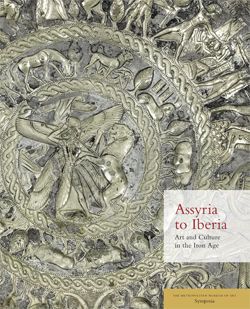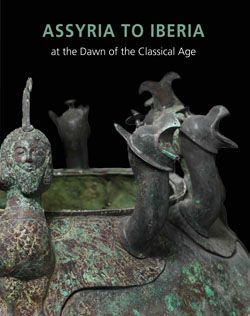Horse frontlet carved in relief with a female figure flanked by lions
Not on view
Over two hundred ivory and gypsum alabaster equestrian bridle-harness ornaments have been found at Nimrud. The majority, including this fragmentary triangular frontlet which adorned a horse’s forehead, were found in a large storeroom (Room SW 37) at Fort Shalmaneser, a royal building at Nimrud that was probably used to store tribute and booty collected by the Assyrians while on military campaign. Although equestrian bridle-harness ornaments in similar form are shown in Neo-Assyrian palace reliefs, it is not possible to know whether the ornaments in the reliefs were meant to represent work in ivory or in more durable materials such as bronze or iron. Ivory pieces like this one may have been used ceremonially, as votive dedications or as processional regalia, rather than in battle. Carved in high relief, four holes at the upper edge suggest that this piece was fastened to another material, perhaps a textile or leather backing that has not survived. This plaque has been attributed to the South Syrian style because it combines Egyptianizing elements characteristic of Phoenician style ivories, including the winged disc with uraei (mythical, fire-spitting serpents) that crown the scene, with North Syrian elements such as the arresting frontal gaze of a nude, elaborately adorned female figure. The figure’s deeply drilled pupils indicate that they were originally enlivened with inlays of colored glass or semiprecious stone. She wears a rectangular diadem with pendants, heavy hoop earrings, a thick necklace, and six rings around either ankle. Bordered by two lotus blossoms, and balancing on a third, she clasps the hind legs of two lions that flank her, in a composition whose symmetry is characteristically Phoenician.
Built by the Assyrian king Ashurnasirpal II, the palaces and storerooms of Nimrud housed thousands of pieces of carved ivory. Most of the ivories served as furniture inlays or small precious objects such as boxes. While some of them were carved in the same style as the large Assyrian reliefs lining the walls of the Northwest Palace, the majority of the ivories display images and styles related to the arts of North Syria and the Phoenician city-states. Phoenician style ivories are distinguished by their use of imagery related to Egyptian art, such as sphinxes and figures wearing pharaonic crowns, and the use of elaborate carving techniques such as openwork and colored glass inlay. North Syrian style ivories tend to depict stockier figures in more dynamic compositions, carved as solid plaques with fewer added decorative elements. However, some pieces do not fit easily into any of these three styles. Most of the ivories were probably collected by the Assyrian kings as tribute from vassal states, and as booty from conquered enemies, while some may have been manufactured in workshops at Nimrud. The ivory tusks that provided the raw material for these objects were almost certainly from African elephants, imported from lands south of Egypt, although elephants did inhabit several river valleys in Syria until they were hunted to extinction by the end of the eighth century B.C.
This image cannot be enlarged, viewed at full screen, or downloaded.
This artwork is meant to be viewed from right to left. Scroll left to view more.





